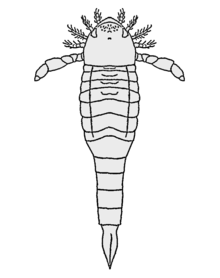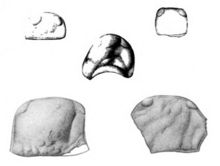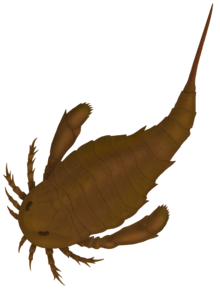Waeringopteridae
Waeringopteridae is a family of eurypterids, an extinct group of aquatic arthropods. The Waeringopteridae is the only family classified as part of the superfamily Waeringopteroidea, which in turn is classified within the infraorder Diploperculata in the suborder Eurypterina. The earliest known member of the group, Orcanopterus, has been recovered from deposits of Katian (Late Ordovician) age and the latest known surviving member, Grossopterus, has been recovered from deposits of Siegenian (Early Devonian) age. The name Waeringopteridae is derived from the type genus Waeringopterus, which is named in honor of eurypterid researcher Erik N. Kjellesvig-Waering.
| Waeringopteridae | |
|---|---|
 | |
| Orcanopterus | |
| Scientific classification | |
| Kingdom: | Animalia |
| Phylum: | Arthropoda |
| Subphylum: | Chelicerata |
| Order: | †Eurypterida |
| Suborder: | †Eurypterina |
| Infraorder: | †Diploperculata |
| Superfamily: | †Waeringopteroidea Tetlie, 2004 Not formally published |
| Family: | †Waeringopteridae Tetlie, 2004 Not formally published |
| Type species | |
| †Waeringopterus cumberlandicus Swartz, 1923 | |
| Genera | |
| Synonyms | |
| |
Waeringopterid fossils are very rare and the family only contains five known species classified in three different genera (Waeringopterus, Orcanopterus and Grossopterus). Four of these species are from the ancient continent of Laurentia, with the only species known from outside of it being a Devonian species recovered from Germany. It is thus considered likely that the group originated in Laurentia before spreading to Germany during the Devonian. As the fossil record of the group is extremely poor, little is known of the morphology of the taxa within the group.
Although confirmed by phylogenetic analyses as monophyletic, and routinely used within eurypterid taxonomy,[1][2][3] "Waeringopteroidea" and "Waeringopteridae" are as of yet not formally published clades, the names instead deriving from a 2004 thesis by O. Erik Tetlie. Some researchers refer to the group more formally as the "waeringopteroid clade" rather than as the superfamily "Waeringopteroidea", pending a formal publication.[4]
Description

Although waeringopterid fossils remain rare and in most cases fragmentary and very little concrete information on the group can confidently be established due to the poor fossil record,[1] the waeringopterid eurypterids are joined together by a handful of known features shared by all genera within the group.[5]
Like all other chelicerates, and other arthropods in general, waeringopterid eurypterids possessed segmented bodies and jointed appendages (limbs) covered in a cuticle composed of proteins and chitin. The chelicerate body is divided into two tagmata (sections); the frontal prosoma (head) and posterior opisthosoma (abdomen). In the waeringopterids, the fifth pair of appendages were spiniferous. The telson (the posteriormost segment of the body) was xiphous (long and pointed). The eyes of waeringopterid eurypterids were located close to the marginal rim of the carapace (the "head" plate).[5]
The waeringopterids were almost all small eurypterids. Waeringopterus cumberlandicus reached 15 cm (5.9 in) in length, while Grossopterus overathi reached 30 cm (11.8 in). Orcanopterus manitoulinensis reached 60 cm (23.6 in) in length. Though this is relatively long in comparison to modern arthropods, other members of Diploperculata, such as the pterygotids or the carcinosomatids, reached much larger sizes, surpassing two meters.[6]
Classification
The Waeringopteridae is the only family within the superfamily Waeringopteroidea and contains the genera Grossopterus, Orcanopterus and Waeringopterus.[2] The cladogram below presents the inferred phylogenetic positions of most of the genera included in the three most derived superfamilies of the Eurypterina suborder of eurypterids (Adelophthalmoidea, Pterygotioidea and the waeringopteroids), as inferred by O. Erik Tetlie and Markus Poschmann in 2008, based on the results of a 2008 analysis specifically pertaining to the Adelophthalmoidea and a preceding 2004 analysis.[7]
| Diploperculata |
| ||||||||||||||||||||||||||||||||||||||||||||||||||||||||||||||||||||||||||||||||||||||||||
"Waeringopteridae" and the superfamily that includes it, "Waeringopteroidea" (named after eurypterid researcher Erik N. Kjellesvig-Waering), are not formally published clades. The names derive from a 2004 thesis by O. Erik Tetlie and are as such not actually technically valid names. Nevertheless, as phylogenetic analyses confirms the grouping as monophyletic and the names supply an easy way to refer to the group, they remain routinely used within studies centered around eurypterid taxonomy. In these studies, the names are usually within quotation marks and/or are noted to not be properly valid names that derive from a thesis.[1][2][3] The group is also sometimes referred to as the "waeringopteroid clade" rather than as the "Waeringopteroidea" within studies to differentiate it from the properly described superfamilies, pending the formal publication of Waeringopteroidea.[4]
Distribution and paleobiogeography
Out of the five known waeringopterid species, four are from the fossil deposits in areas that were part of the ancient continent of Laurentia. Only the last known surviving species, Grossopterus overathi, from the Devonian of Germany, is known from outside of Laurentia and it is thus assumed that the group originated in Laurentia before they spread to modern-day Germany in the Devonian. Further fossil finds are required to properly study the distribution and evolutionary history of the group.[1] The temporal range of the group extends from the Late Ordovician (Orcanopterus) to the Early Devonian (Grossopterus).[8][9]
See also
References
- O. Erik Tetlie (2007). "Distribution and dispersal history of Eurypterida (Chelicerata)" (PDF). Palaeogeography, Palaeoclimatology, Palaeoecology. 252 (3–4): 557–574. doi:10.1016/j.palaeo.2007.05.011. Archived from the original (PDF) on 2011-07-18.
- Dunlop, J. A., Penney, D. & Jekel, D. 2015. A summary list of fossil spiders and their relatives. In World Spider Catalog. Natural History Museum Bern, online at http://wsc.nmbe.ch, version 16.0 http://www.wsc.nmbe.ch/resources/fossils/Fossils16.0.pdf (PDF).
- Tetlie, O. Erik; Cuggy, Michael B. (2007-01-01). "Phylogeny of the basal swimming eurypterids (Chelicerata; Eurypterida; Eurypterina)". Journal of Systematic Palaeontology. 5 (3): 345–356. doi:10.1017/S1477201907002131. ISSN 1477-2019.
- Lamsdell, James; Hoşgör, Izzet; Selden, Paul (2013-01-31). "A new Ordovician eurypterid (Arthropoda: Chelicerata) from southeast Turkey: Evidence for a cryptic Ordovician record of Eurypterida". Gondwana Research. 23: 354–366. doi:10.1016/j.gr.2012.04.006.
- "Lille1tv - Eurypterid phylogeny and the origin of Arachnida". lille1tv.univ-lille1.fr. Retrieved 2018-04-02.
- Lamsdell, James C.; Braddy, Simon J. (2009-10-14). "Cope's Rule and Romer's theory: patterns of diversity and gigantism in eurypterids and Palaeozoic vertebrates". Biology Letters: rsbl20090700. doi:10.1098/rsbl.2009.0700. ISSN 1744-9561. PMID 19828493. Supplementary information
- Erik Tetlie, O; Poschmann, Markus (2008-06-01). "Phylogeny and palaeoecology of the Adelophthalmoidea (Arthropoda; Chelicerata; Eurypterida)". Journal of Systematic Palaeontology. 6 (2): 237–249. doi:10.1017/S1477201907002416.
- Stott, Tetlie; et al. (2005). "A New Eurypterid From the Upper Ordovician of Manitoulin Island, Ontario, Canada". Journal of Paleontology. 79 (6): 1166–1174. doi:10.1666/0022-3360(2005)079[1166:ANECFT]2.0.CO;2.
- Dunlop, Jason A.; Braddy, Simon J.; Tetlie, Erik (2008). "The Early Devonian eurypterid Grossopterus overathi (Gross, 1933) from Overath, Germany". Fossil Record. 5 (1): 93–104. doi:10.1002/mmng.20020050107. ISSN 1860-1014.
